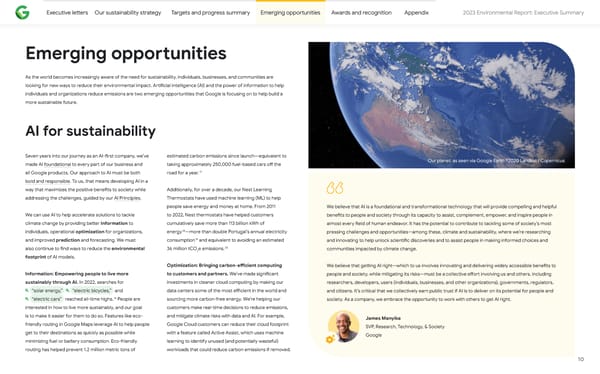Executive le琀琀ers Our sustainability strategy Targets and progress summary Emerging oppo爀琀unities Awards and recognition Appendix 2023 Environmental Repo爀琀: Executive Summary Emerging oppo爀琀unities As the world becomes increasingly aware of the need for sustainability, individuals, businesses, and communities are looking for new ways to reduce their environmental impact. A爀琀i昀椀cial intelligence (AI) and the power of information to help individuals and organizations reduce emissions are two emerging oppo爀琀unities that Google is focusing on to help build a more sustainable future. AI for sustainability Seven years into our journey as an AI-昀椀rst company, we’ve estimated carbon emissions since launch—equivalent to made AI foundational to every pa爀琀 of our business and taking approximately 250,000 fuel-based cars o昀昀 the Our planet, as seen via Google Ea爀琀h ©2020 Landsat / Copernicus 17 all Google products. Our approach to AI must be both road for a year. bold and responsible. To us, that means developing AI in a way that maximizes the positive bene昀椀ts to society while Additionally, for over a decade, our Nest Learning addressing the challenges, guided by our AI Principles. Thermostats have used machine learning (ML) to help people save energy and money at home. From 2011 We believe that AI is a foundational and transformational technology that will provide compelling and helpful We can use AI to help accelerate solutions to tackle to 2022, Nest thermostats have helped customers bene昀椀ts to people and society through its capacity to assist, complement, empower, and inspire people in climate change by providing be琀琀er information to cumulatively save more than 113 billion kWh of almost every 昀椀eld of human endeavor. It has the potential to contribute to tackling some of society’s most 18 individuals, operational optimization for organizations, energy —more than double Po爀琀ugal’s annual electricity pressing challenges and oppo爀琀unities—among these, climate and sustainability, where we’re researching 19 and improved prediction and forecasting. We must consumption and equivalent to avoiding an estimated and innovating to help unlock scienti昀椀c discoveries and to assist people in making informed choices and 20 also continue to 昀椀nd ways to reduce the environmental 36 million tCO e emissions. 2 communities impacted by climate change. footprint of AI models. Optimization: Bringing carbon-e昀케cient computing We believe that ge琀琀ing AI right—which to us involves innovating and delivering widely accessible bene昀椀ts to Information: Empowering people to live more to customers and pa爀琀ners. We’ve made signi昀椀cant people and society, while mitigating its risks—must be a collective e昀昀o爀琀 involving us and others, including sustainably through AI. In 2022, searches for investments in cleaner cloud computing by making our researchers, developers, users (individuals, businesses, and other organizations), governments, regulators, “solar energy,” “electric bicycles,” and data centers some of the most e昀케cient in the world and and citizens. It’s critical that we collectively earn public trust if AI is to deliver on its potential for people and 16 “electric cars” reached all-time highs. People are sourcing more carbon-free energy. We’re helping our society. As a company, we embrace the oppo爀琀unity to work with others to get AI right. interested in how to live more sustainably, and our goal customers make real-time decisions to reduce emissions, is to make it easier for them to do so. Features like eco- and mitigate climate risks with data and AI. For example, James Manyika friendly routing in Google Maps leverage AI to help people Google Cloud customers can reduce their cloud footprint SVP, Research, Technology, & Society get to their destinations as quickly as possible while with a feature called Active Assist, which uses machine Google minimizing fuel or ba琀琀ery consumption. Eco-friendly learning to identify unused (and potentially wasteful) routing has helped prevent 1.2 million metric tons of workloads that could reduce carbon emissions if removed. 10
 Executive Summary Page 9 Page 11
Executive Summary Page 9 Page 11